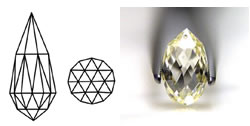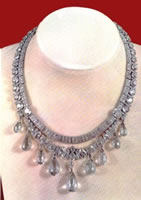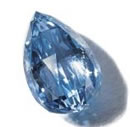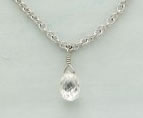 The Briolette Cut is a drop-shaped stone with triangular or diamond-shaped facets all the way around. There is no table, crown or pavilion. The more facets, the more brilliant the stone appears. The facets on a Briolette are all triangular in shape entirely covering the circular cross section of the stone.
The Briolette Cut is a drop-shaped stone with triangular or diamond-shaped facets all the way around. There is no table, crown or pavilion. The more facets, the more brilliant the stone appears. The facets on a Briolette are all triangular in shape entirely covering the circular cross section of the stone.
 Briolette diamonds are found in antique and estate jewelry from the Victorian, Edwardian and Art Deco eras. Briolettes are one of the earliest diamond cuts. In or about 1476 Lodewyk (Louis) van Berquem, a Flemish polisher of Bruges, introduced absolute symmetry in the design of facets. He cut stones in the shape known as pendeloque or briolette. Briolette cut diamonds also are being newly cut, especially in larger sizes like 10 to 12 carats, primarily in India. Even larger Briolettes, up to 50 carats, are being cut in New York City.
Briolette diamonds are found in antique and estate jewelry from the Victorian, Edwardian and Art Deco eras. Briolettes are one of the earliest diamond cuts. In or about 1476 Lodewyk (Louis) van Berquem, a Flemish polisher of Bruges, introduced absolute symmetry in the design of facets. He cut stones in the shape known as pendeloque or briolette. Briolette cut diamonds also are being newly cut, especially in larger sizes like 10 to 12 carats, primarily in India. Even larger Briolettes, up to 50 carats, are being cut in New York City.
 Most Briolettes are cut from white rough, but colored diamond Briolettes, especially fancy and canary yellows, are increasing in demand, followed by cognacs and other champagne colors. The cut is also very popular for color gemstones.
Most Briolettes are cut from white rough, but colored diamond Briolettes, especially fancy and canary yellows, are increasing in demand, followed by cognacs and other champagne colors. The cut is also very popular for color gemstones.
Every Briolette is unique, so look for beauty. Look for well-cut stones that have lots of brilliancy, which are usually more round in shape. Be careful if the shape is to free-form. If not round or pear-shaped, they can have a “baked potato” effect where they lose brilliancy.
 During the 18th and early 19th centuries as technology and science progressed, many historic traditions fell by the wayside. Gem cutters were not immune from these “advances”, abandoning historic cuts in favor of the precursors to the modern table-crown-pavilion cuts we see today. Traditional historic cut gemstones were recut to the new standards. Old cutting styles disappeared. An ancient art form was lost. Briolettes were among the casualties.
During the 18th and early 19th centuries as technology and science progressed, many historic traditions fell by the wayside. Gem cutters were not immune from these “advances”, abandoning historic cuts in favor of the precursors to the modern table-crown-pavilion cuts we see today. Traditional historic cut gemstones were recut to the new standards. Old cutting styles disappeared. An ancient art form was lost. Briolettes were among the casualties.
 It wasn’t until the Victorian and Art Deco periods that Briolettes rose to prominence again, only to fade with the depression and post war years of the 20th century. Once again gems were being cut to new standards set in the diamond industry. Briolettes were viewed as an inefficient use of gem rough. They were a victim of “progress”. With the arrival of the millennium and renewed appreciation for history, briolette popularity is on the rise.
It wasn’t until the Victorian and Art Deco periods that Briolettes rose to prominence again, only to fade with the depression and post war years of the 20th century. Once again gems were being cut to new standards set in the diamond industry. Briolettes were viewed as an inefficient use of gem rough. They were a victim of “progress”. With the arrival of the millennium and renewed appreciation for history, briolette popularity is on the rise.
Briolette diamonds are popular with designer-manufacturers, designer retailers and in the auction market. Antique and estate dealers look for Briolettes to replace broken or lost stones in old jewelry. Often the antique ones have broken tops that then have to be recut and re-drilled. Briolettes are sold unmounted and mounted. Briolettes are set in earrings, necklaces and pendants. In antique or estate jewelry, they are also included in tiaras.
